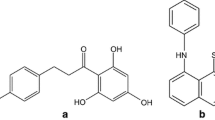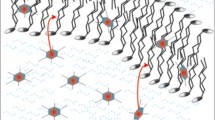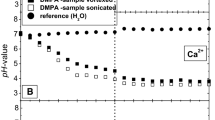Abstract
Site specific spectroscopic techniques and differential scanning calorimetry were used to study human serum albumin (HSA) in the absence and in the presence of membranes composed of dipalmitoylphosphatidylcholine (DPPC) and poly(ethylene glycol:2000)-dipalmitoylphosphatidylethanolamine (PEG:2000-DPPE). Electron spin resonance (ESR) of a maleimide spin-label (5-MSL) covalently bound to the free sulfhydryl group at the unique cystein Cys-34 in domain I, intrinsic fluorescence of the single tryptophan Trp-214 in domain II, and extrinsic fluorescence of p-nitrophenyl anthranilate conjugated with tyrosine Tyr-411 in domain III were employed to study HSA dispersions with or without polymer-grafted membranes. On adsorbing at the DPPC membrane surfaces, domain I assumes a more loosened conformation and partitioning of the spin-labelled protein between the aqueous phase and the interfacial region of lipid membranes is observed by ESR. Domain II and III undergo a local structural arrangement which leads Trp-214 and Tyr-411 to come closer and causes intrinsic fluorescence quenching. The influence of DPPC bilayers on HSA is characterized both by a decrease of the thermal unfolding enthalpy and by a slight increase of the transition temperature, T t, of the protein. The lipid induced effects on HSA are progressively reduced on increasing the amounts of PEG:2000-DPPE mixed with DPPC from the mushroom regime to the brush regime. Primary protein adsorption at the lipid surfaces is abolished at 1 mol% of the polymer-lipid, whereas the secondary protein adsorption at the polymer-brush leads to a further increase of both transition enthalpy and T t relative to the case of aqueous dispersions of HSA alone.









Similar content being viewed by others
References
Abreu MSC, Estronca LMBB, Moreno MJ, Vaz WLC (2003) Binding of a fluorescent lipid amphiphile to albumin and its transfer to lipid bilayer membranes. Biophys J 84:386–399
Bartucci R, Pantusa M, Marsh D, Sportelli L (2002) Interaction of human serum albumin with membranes containing polymer-grafted lipids: spin-label ESR studies in the mushroom and brush regimes. Biochim Biophys Acta 1564:237–242
Bosker WTE, Iakovlev PA, Norde W, Cohen Stuart MA (2005) BSA adsorption on bimodal PEO brushes. J Colloid Interface Sci 286:496–503
Carter DC, Ho JX (1994) Structure of serum albumin. Adv Protein Chem 45:152–203
Chiu GN, Bally MB, Mayer LD (2001) Selective protein interactions with phosphatidylserine containing liposomes alter the steric stabilization properties of poly(ethylene glycol). Biochim Biophys Acta 1510:56–69
De Simone F, Guzzi R, Sportelli L, Marsh D, Bartucci R (2007) Electron spin-echo studies of spin-labelled lipid membranes and free fatty acids interacting with human serum albumin. Biochim Biophys Acta 1768:1541–1549
Dimitrova MN, Matsumura H, Dimitrova A, Neitchev VZ (2000) Interaction of albumins from different species with phospholipid liposomes. Multiple binding sites system. Int J Biol Macromol 27:187–194
Dos Santos N, Allen C, Doppen AM, Anantha M, Cox KAK, Gallagher RC, Karlsson G, Edwards K, Kenner G, Samuels L, Webb MS, Bally MB (2007) Influence of poly(ethylene glycol) grafting density and polymer length on liposomes: relating plasma circulation lifetimes to protein binding. Biochim Biophys Acta 1768:1367–1377
Du H, Chandaroy P, Hui SW (1997) Grafted poly(ethylene glycol) on lipid surfaces inhibits protein adsorption and cell adhesion. Biochim Biophys Acta 1326:236–248
Efremova NV, Bondurant B, O’Brien DF, Leckband DE (2000) Measurements of interbilayer forces and protein adsorption on uncharged lipid bilayers displaying poly(ethylene glycol) chains. Biochemistry 39:3441–3451
Fang F, Szleifer I (2006) Controlled release of proteins from polymer-modified surfaces. Proc Natl Acad Sci 103:5769–5774
Fang F, Satulovsky J, Szleifer I (2005) Kinetics of protein adsorption and desorption on surface with grafted polymers. Biophys J 89:1516–1533
Faruggia B, Picò GA (1999) Thermodynamic features of the chemical and thermal denaturations of human serum albumin. Int J Biol Macromol 26:317–323
Galantai R, Bardos-Nagy I (2000) The interaction of human serum albumin and model membranes. Int J Pharm 195:207–218
Galantai R, Bardos-Nagy I, Modos K, Kardos J, Zavodszky P, Fidy J (2000) Serum albumin-lipid membrane interaction influencing the uptake of porphyrins. Arch Biochem Biophys 373:261–270
Graceffa P, Lehrer SS (1984) Dynamic equilibrium between the two conformational states of spin-label tropomyosin. Biochemistry 23:2606–2612
Griffith OH, Jost PC (1976) Lipid spin labels in biological membranes. In: Berliner LJ (ed) Spin labeling. theory and applications. Academic Press, New York, pp 453–523
Hagag N, Birnbaum ER, Darnall DW (1983) Resonance energy transfer between cysteine-34, tryptophan-214 and tyrosine-411 of human serum albumin. Biochemistry 22:2420–2427
Halperin A (1999) Polymer brushes that resist adsorption of model proteins: design parameters. Langmuir 15:2525–2533
Hashizaki K, Taguchi H, Sakai H, Abe M, Saito Y, Ogawa N (2006) Carboxyfluorescein leakage from poly(ethylene glycol)-grafted liposomes induced by the interaction with serum. Chem Farm Bull 54:80–84
He XM, Carter DC (1992) Atomic structure and chemistry of human serum albumin. Nature 358:209–215
Jeon SI, Andrade JD (1991) Protein surface interactions in the presence of polyethylene oxide: 2. effect of protein size. J Colloid Interface Sci 142:159–166
Jeon SI, Lee JH, Andrade JD, De Gennes PG (1991) Protein surface interactions in the presence of polyethylene oxide: 1. simplified theory. J Colloid Interface Sci 142:149–158
Jost P, Griffith OH (1976) Instrumental aspects of spin labelling. In: Berliner LJ (ed) Spin labeling. theory and applications. Academic Press, New York, pp 251–272
Krishnakumar SS, Panda D (2002) Spatial relationship between the prodan site, Trp-124, and Cys-34 residues in human serum albumin and loss of structure through incremental unfolding. Biochemistry 41:7443–7452
Ladokhin AS, Jayasinghe S, White SH (2000) How to measure and analyze tryptophan fluorescence in membranes properly, and why bother? Anal Biochem 285:235–245
Lakowicz JR (1983) Principles of fluorescence spectroscopy. Plenum Press, New York
Lasic DD (1993) Liposomes: from physics to applications. Elsevier, Amsterdam
Lasic DD, Martin F (1995) Stealth liposomes. CRC Press, Boca Raton
Lasic DD, Needham D (1995) The “stealth” liposome: a prototypical biomaterial. Chem Rev 95:2601–2628
Liu X, Shang L, Jiang X, Dong S, Wang E (2006) Conformational changes of β-lactoglobulin induced by anionic phospholipid. Biophys Chem 121:218–223
Marsh D (1981) Electron spin resonance: spin labels. In: Grell E (ed) Membrane spectroscopy. Springer, Berlin, pp 51–115
Marsh D (1982) Electron spin resonance: spin label probes. In: Metcalfe JC, Hesketh TR (eds) Techniques in lipids and membrane biochemistry, vol B4/II. Elsevier, Amsterdam, B426/1–B426/44
Marsh D, Horvath LI (1989) Spin label studies of the structure and dynamics of lipids and proteins in membranes. In: Hoff AJ (ed) Advanced EPR applications in biology and biochemistry. Elsevier, Amsterdam, pp 707–752
Marsh D, Horvath LI (1998) Structure, dynamics and composition of the lipid–protein interface: perspectives from spin-labeling. Biochim Biophys Acta 1376:267–296
Marsh D, Bartucci R, Sportelli L (2003) Lipid membranes with grafted polymers: physicochemical aspects. Biochim Biophys Acta 1615:33–59
Michnik A, Michalik K, Drzazga Z (2005) Stability of bovine serum albumin at different pH. J Therm Anal Calorim 80:399–406
Muzammil S, Kumar Y, Tayyab S (1999) Molten globule-like state of human serum albumin at low pH. Eur J Biochem 266:26–32
Narazaki R, Maruyama T, Otagiri M (1997) Probing the cysteine 34 residue in human serum albumin using fluorescence techniques. Biochim Biophys Acta 1338:275–281
Norde W, Gage D (2004) Interaction of bovine serum albumin and human blood plasma with PEO-tethered surfaces: influence of PEO chain length, grafting density and temperature. Langmuir 20:4162–4167
Pantusa M, Sportelli L, Bartucci R (2005) Transfer of stearic acids from albumin to polymer-grafted lipid containing membranes probed by spin-label electron spin resonance. Biophys Chem 114:121–127
Peters T (1995) All about albumin: biochemistry, genetics and medical applications. Academic Press, San Diego
Pico GA (1997) Thermodynamic features of the thermal unfolding of human serum albumin. Int J Biol Macromol 20:63–73
Price ME, Cornelius RM, Brash JL (2001) Protein adsorption to polyethylene glycol modified liposomes from fibrinogen solution and from plasma. Biochim Biophys Acta 1512:191–205
Ragi C, Sedaghat-Herati MR, Ahmed Ouameur A, Tajmir-Riahi HA (2005) The effects of poly(ethylene glycol) on the solution structure of human serum albumin. Biopolymers 78:231–236
Ren J, Lew S, Wang Z, London E (1997) Transmembrane orientation of hydrophobic α-helices is regulated both by the relationship of helix length to bilayer thickness and by the cholesterol concentration. Biochemistry 36:10213–10220
Rixman MA, Dean D, Ortiz C (2003) Nanoscale intermolecular interaction between human serum albumin and low grafting density surfaces of poly(ethylene oxide). Langmuir 19:9357–9372
Santra MK, Banerjee A, Rahaman O, Panda D (2005) Unfolding pathways of human serum albumin: evidence for sequential unfolding of its three domains. Int J Biol Macromol 37:200–204
Shrake A, Frazier D, Schwarz FP (2006) Thermal stabilization of human albumin by medium- and short-chain n-alkyl fatty acid anions. Biopolymers 81:235–248
Sterk M, Hauser H, Marsh D, Gehring H (1994) Probing conformational states of spin-labeled aspartate aminotransterase by ESR. Eur J Biochem 219:993–1000
Sugio S, Kashima A, Mochizuki S, Noda M, Kobayashi K (1999) Cristal structure of human serum albumin at 2.5 Å resolution. Protein Eng 12:439–446
Szleifer I (1997) Protein adsorption on surface with grafted polymers: a theoretical approach. Biophys J 72:595–612
Wang X, Zhang Y, Wu J, Wang M, Cui G, Li J, Brezesinski G (2002) Dynamical and morphological studies on the adsorption and penetration of human serum albumin into phospholipid monolayers at the air/water interface. Colloids Surf B 23:339–347
Wang X, He Q, Zheng S, Brezesinski G, Mohwald H, Li (2004) J structural changes of phospholipid monolayers caused by coupling of human serum albumin: a GIXD study at the air/water interface. J Phys Chem B 108:14171–14177
Wetzel R, Becker M, Behlke J, Billwitz H, Bohm S, Ebert B, Hamann H, Krumbiegel J, Lassmann G (1980) Temperature behaviour of human serum albumin. Eur J Biochem 104:469–478
Acknowledgments
Manuela Pantusa thanks the University of Calabria for a research grant. This work was financially supported by University of Calabria.
Author information
Authors and Affiliations
Corresponding author
Rights and permissions
About this article
Cite this article
Pantusa, M., Sportelli, L. & Bartucci, R. Spectroscopic and calorimetric studies on the interaction of human serum albumin with DPPC/PEG:2000-DPPE membranes. Eur Biophys J 37, 961–973 (2008). https://doi.org/10.1007/s00249-008-0314-z
Received:
Revised:
Accepted:
Published:
Issue Date:
DOI: https://doi.org/10.1007/s00249-008-0314-z




